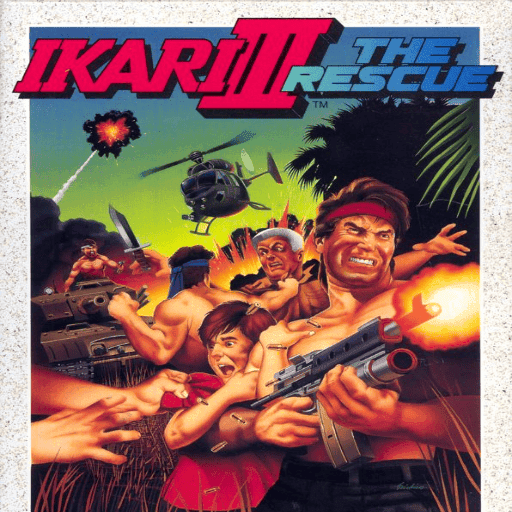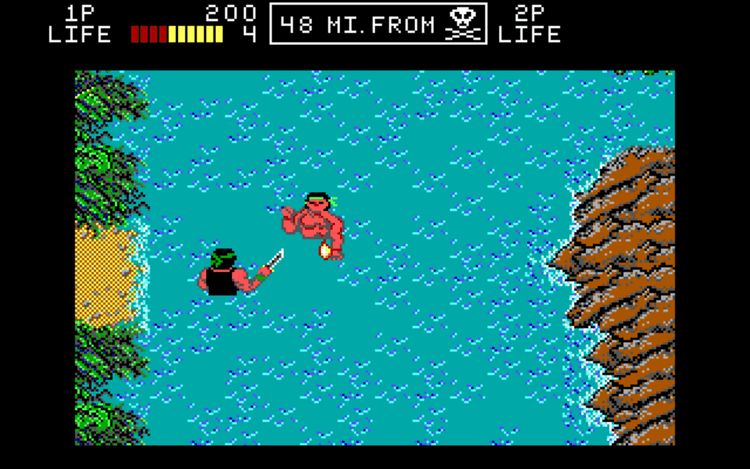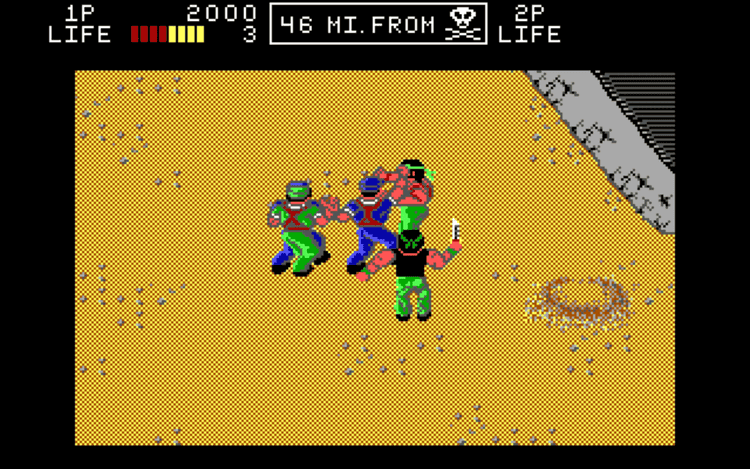
Ikari III: The Rescue is a hard-hitting action game from SNK that blends overhead run-and-gun combat with close-quarters brawling. You’ll infiltrate enemy strongholds, switch between fists and firearms, and master timing across compact, trap-filled arenas. The pacing recalls the relentless firefights of Contra while the hand-to-hand emphasis echoes the street-fighting rhythm of Double Dragon. Tight stage design, punchy audiovisual feedback, and a straightforward rescue plot keep the focus on moment-to-moment play. Whether you want to play online for a quick session or dive deep into score-chasing, this game delivers old-school challenge and immediately readable action.
Ikari III: The Rescue marks a confident return to the battlefield from SNK, a publisher synonymous with arcade-sharp action and memorable heroes. While the premise is classic—storm hostile territory to rescue a high-value captive—the execution is what makes the game endure. This overhead action adventure strips the genre to its essentials: movement, attack, spacing, and survival. It walks a tightrope between run-and-gun firefights and martial-arts duels, demanding agility one moment and precise melee the next. The result is a rhythm that keeps you alert, scanning for the instant where a dodge, a jab, or a short burst of fire will turn the tide.
Enemies arrive in squads, patterns, and ambushes, teaching you to read the screen like a tactical map. Health management is strict, item drops are purposeful, and boss encounters punish hesitation. The lean storytelling enhances the pace; every new screen feels like a forward sprint, every cleared room a minor triumph. Ikari III is not about lore—it’s about momentum, mastery, and the thrill of wrestling back control under pressure.
What distinguishes Ikari III from many contemporaries is the fluid switch between ranged and melee combat. Ammunition is limited enough to matter, so guns become punctuation marks rather than a constant drumbeat. You’ll learn to soften a formation with a few shots, then close the distance to finish with kicks and punches that conserve resources and clear space. The melee system is simple, yet it rewards position and timing; even a basic strike feels satisfying when it intercepts a charging foe or interrupts a grenade thrower.
Stage layouts amplify these decisions. Corridors, courtyards, and narrow bridges create micro-puzzles: where do you stand to funnel the rush, when do you flank, when do you retreat to reset? Hazards and environmental obstacles add friction, asking for small, meaningful adjustments. The game rarely pauses to explain; it knows you understand the language of classic action—the nudge that invites a sidestep, the tell that warns a boss attack is about to land. In a few minutes, you’ll internalize rules that make the entire adventure feel readable and fair, even when it’s demanding.
The presentation favors clarity. Sprites are compact and distinct, projectiles are visible at a glance, and explosions telegraph threat without clutter. Animation sells impact: a quick recoil here, a stagger there, the snap of a kick that connects cleanly. The palette and background work ensure that foreground action never gets lost. Audio cues reinforce the flow—short effects that let you parse what just happened and what’s coming next. In practice, you’ll start playing by ear as much as by eye, reacting to the bark of a shot or the ping of an item before your brain has fully verbalized it.
Difficulty in Ikari III is firm but honest. Early sections serve as skill onboarding—movement discipline, spacing with melee, ammo logic. Later areas expect composure when multiple threats overlap: a sniper off-screen, a brawler up close, and a grenade arcing toward your feet. Because the systems are lean, failures feel attributable to your decisions rather than surprises you couldn’t foresee. That’s the heart of classic action design: learn, adapt, and enjoy the satisfaction of clearing a room you once thought impossible.
Even with a compact toolset, there’s room for expression. Some players favor cautious pulls, luring enemies into controlled spaces. Others sprint aggressively, relying on fast melee interrupts and quick target prioritization. Bosses underscore this flexibility; a fight that seems overwhelming can turn manageable once you spot the safe angles or the moment to commit to close combat. The game’s brevity becomes an advantage—replays encourage experimentation, route refinement, and faster clears.
Ikari III: The Rescue translates well to quick sessions and longer runs alike, making it ideal for players who want immediate action without setup. You can play Ikari III: The Rescue online for free, right in a browser, and it works smoothly on mobile devices without restrictions. The overhead perspective and crisp hit detection remain readable on a phone screen, while desktop play preserves that arcade feel. Whether you’re revisiting a favorite or discovering it for the first time, the game’s tight mechanics and rapid feedback loop shine in short bursts and marathon attempts.
If you’re drawn to classics that balance shooting and striking, Ikari III stands shoulder to shoulder with genre touchstones. It favors player knowledge over raw grinding, rewarding those who study enemy approach vectors, memorize grab-range spacing, and ration limited resources. The more you practice, the more elegant your movement becomes—tiny diagonals to slip past incoming fire, a step-in punch that cancels a rush, a disciplined retreat that turns a mob into a line.
Ikari III endures because it is legible, brisk, and proud of its purpose. It’s a game about clarity under pressure: recognizing danger, acting with precision, and turning a losing scramble into a textbook clear. The audiovisual style communicates information first and spectacle second, and that choice gives the action a timeless edge. The rescue plot is a simple thread, but it adds stakes to every push forward. Even after you finish, it invites you back for cleaner runs and tighter execution.
At a glance, it might appear modest compared to sprawling modern adventures, yet few games deliver such a concentrated dose of skill-driven satisfaction. In an era of lavish complexity, Ikari III’s restraint feels refreshing. Every second on the clock is about you and the next decision.
Ikari III: The Rescue remains a sharp, disciplined action experience from SNK, leveraging compact stages, purposeful resource limits, and a rewarding mix of firearms and martial arts. To control the game, move with deliberate diagonals to manage lines of fire, use punches and kicks to conserve ammo at close range, and time short bursts from your weapons to break enemy formations before they surround you.
All used codes are publicly available and the game belongs to its original authors.
Share game
Share game




Share game